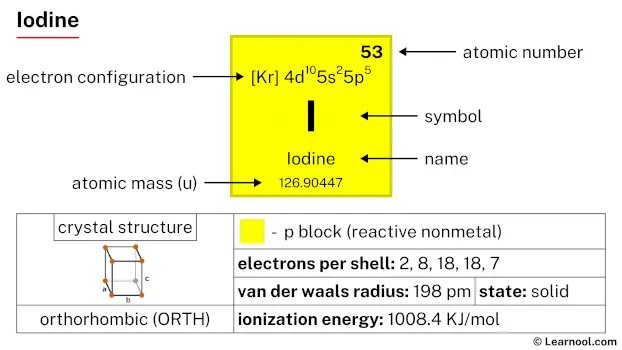
Iodine (I) is a chemical element of the periodic table, located in the group 17 and the period 5, and has the atomic number 53. It is a lustrous, black reactive nonmetal, whose name comes from the Greek word “iodes”, which means violet. It is counted as one of the heaviest elements in the halogen group.
On periodic table
| group | ⇨ | 1 | 2 | 3 | 4 | 5 | 6 | 7 | 8 | 9 | 10 | 11 | 12 | 13 | 14 | 15 | 16 | 17 | 18 |
| period | ⇩ | ||||||||||||||||||
| 1 | 1 H 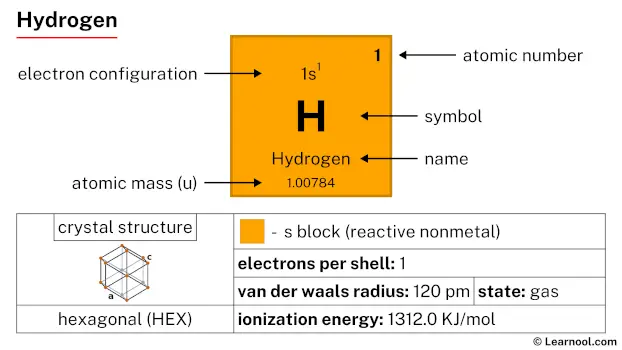 Hydrogen |
2 He  Helium |
|||||||||||||||||
| 2 | 3 Li  Lithium |
4 Be 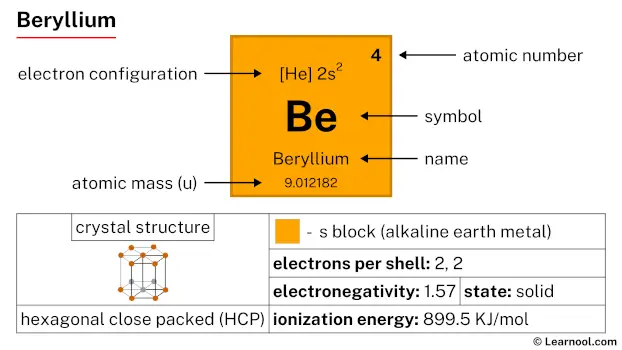 Beryllium |
5 B 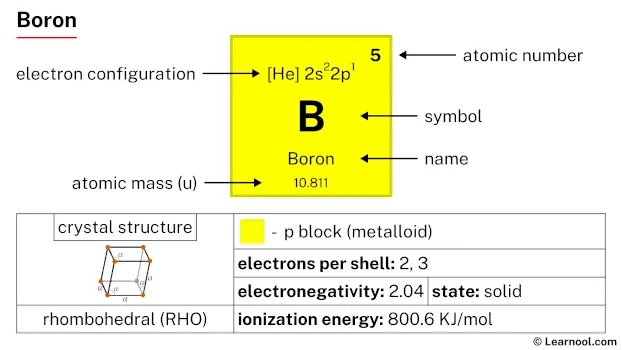 Boron |
6 C  Carbon |
7 N 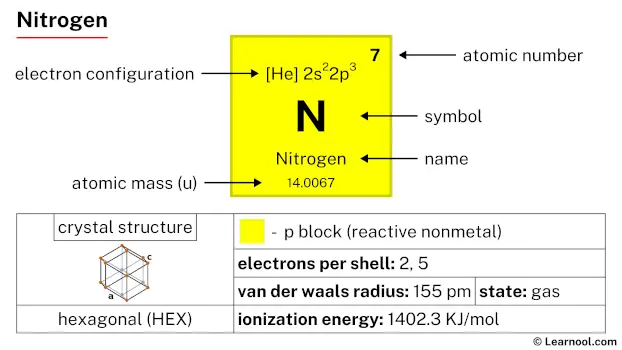 Nitrogen |
8 O 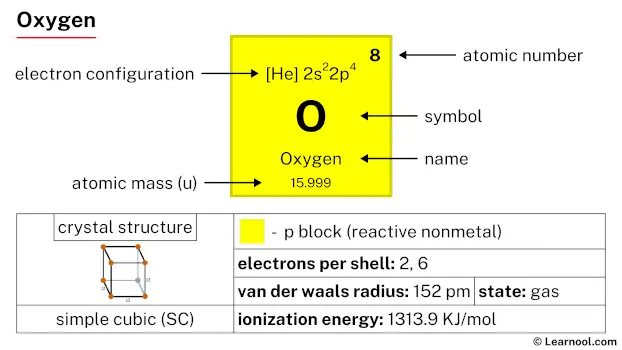 Oxygen |
9 F 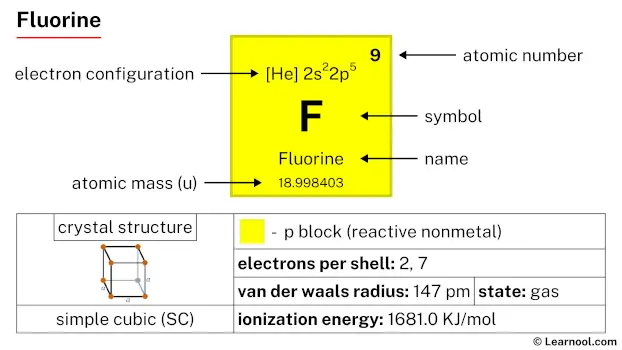 Fluorine |
10 Ne 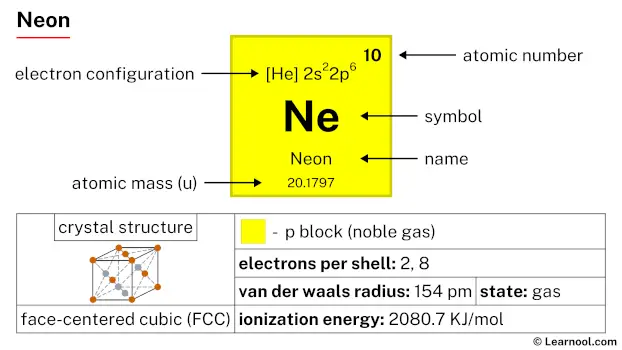 Neon |
|||||||||||
| 3 | 11 Na 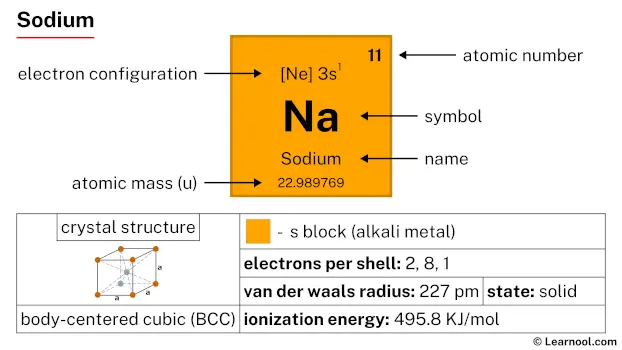 Sodium |
12 Mg 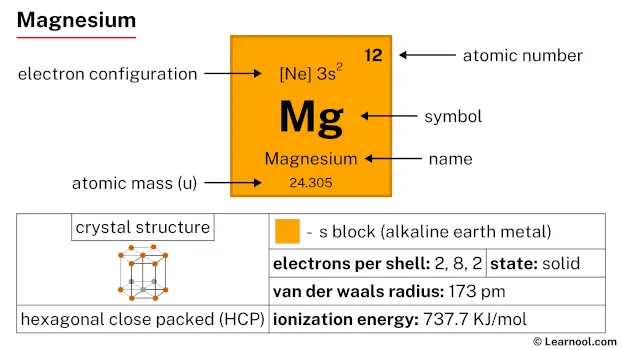 Magnesium |
13 Al  Aluminium |
14 Si Silicon |
15 P 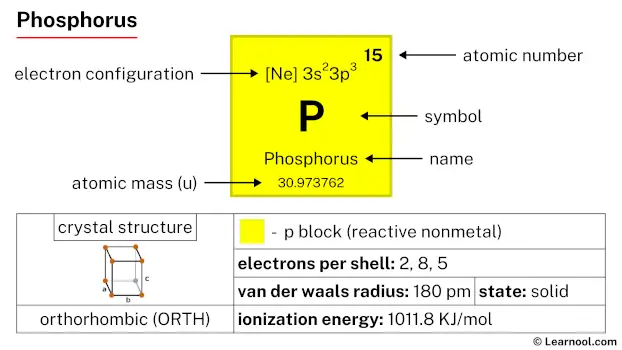 Phosphorus |
16 S 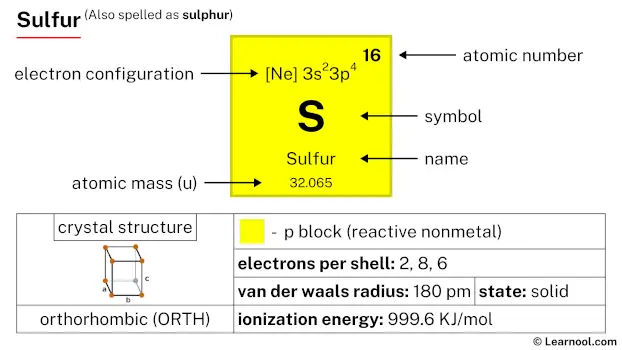 Sulfur |
17 Cl 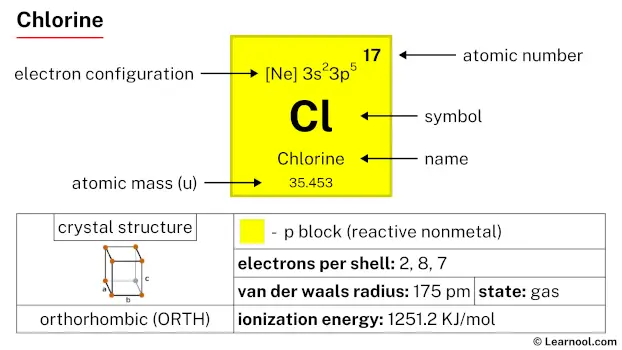 Chlorine |
18 Ar 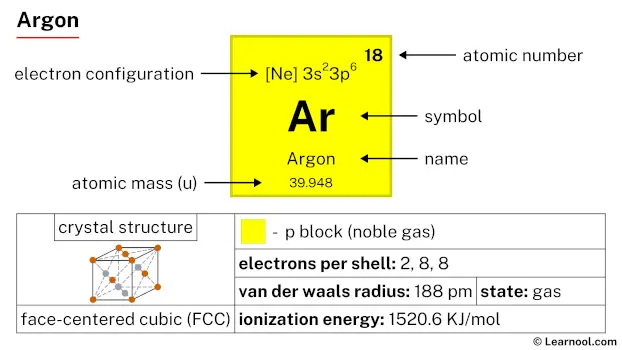 Argon |
|||||||||||
| 4 | 19 K 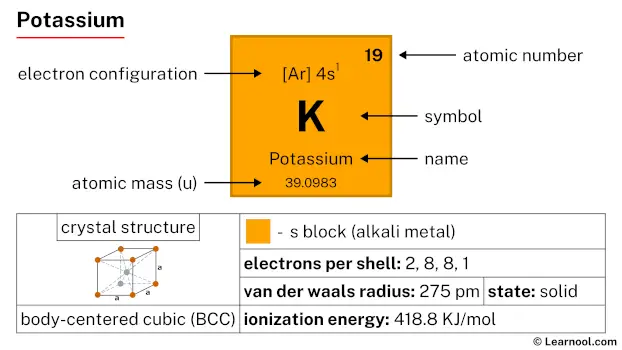 Potassium |
20 Ca 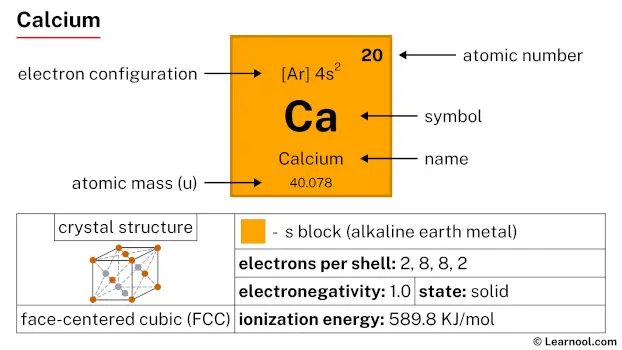 Calcium |
21 Sc 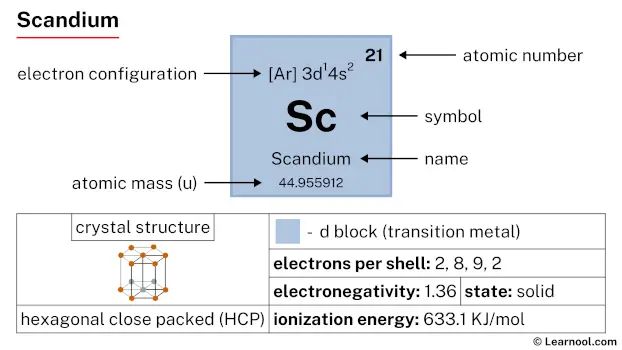 Scandium |
22 Ti 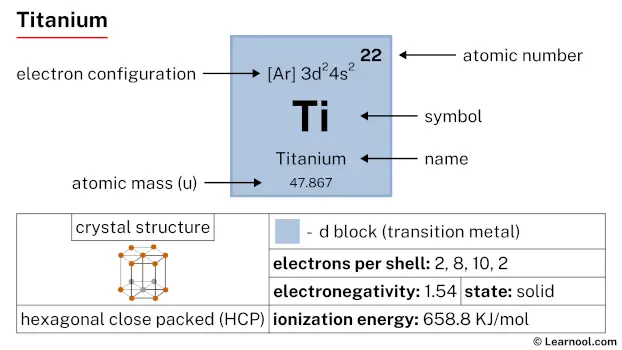 Titanium |
23 V 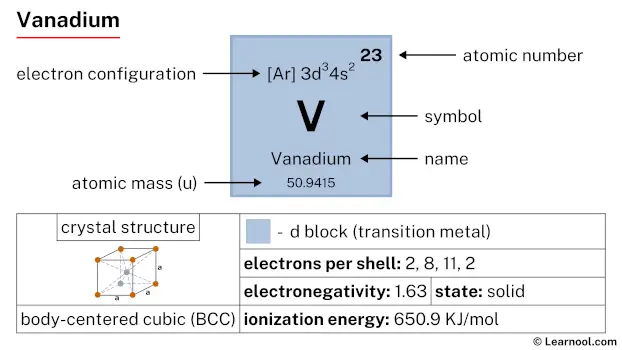 Vanadium |
24 Cr 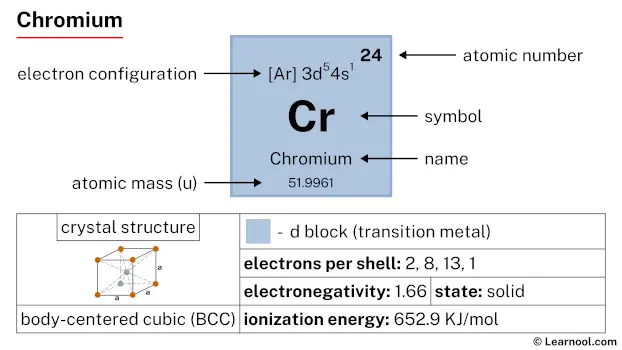 Chromium |
25 Mn 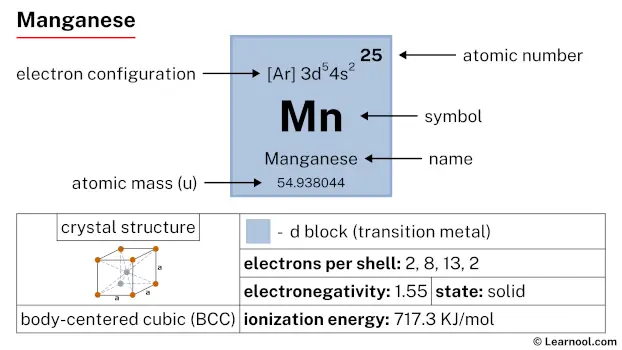 Manganese |
26 Fe 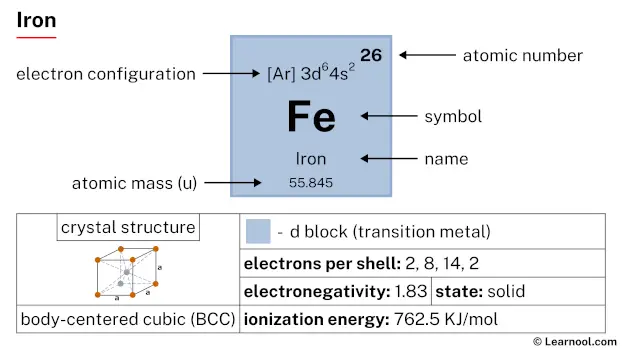 Iron |
27 Co 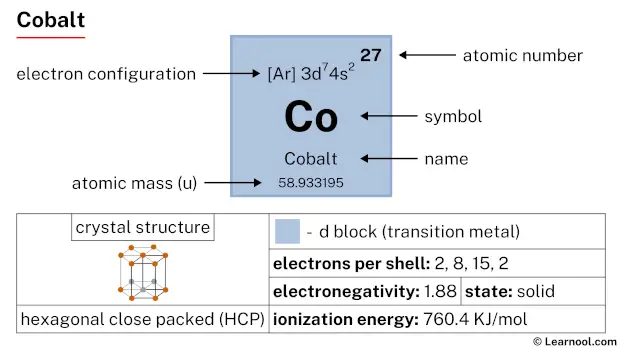 Cobalt |
28 Ni 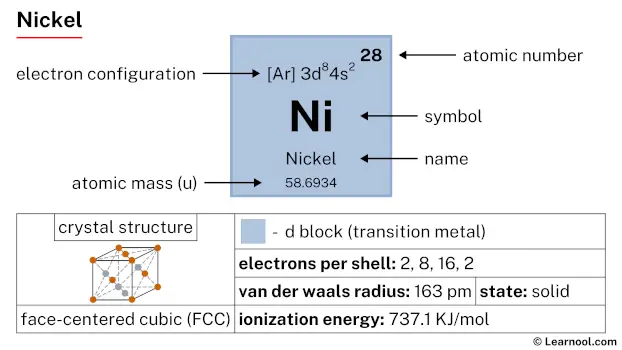 Nickel |
29 Cu 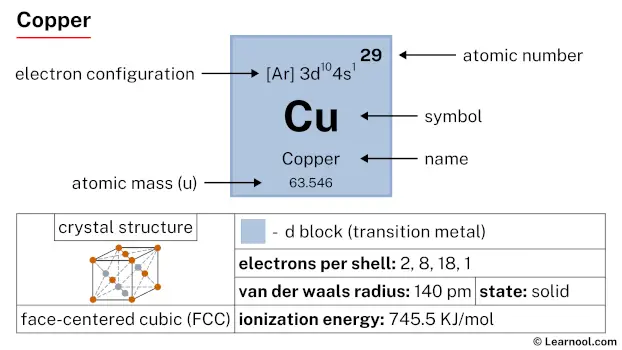 Copper |
30 Zn  Zinc |
31 Ga 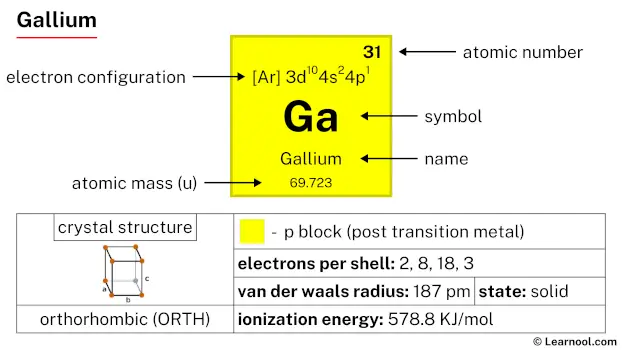 Gallium |
32 Ge 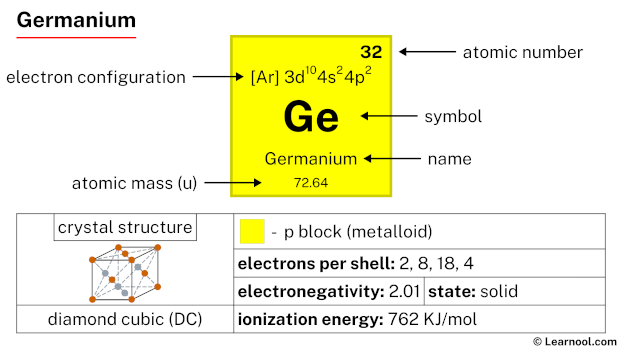 Germanium |
33 As 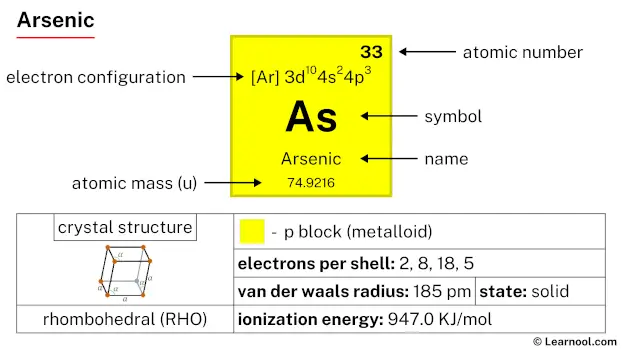 Arsenic |
34 Se 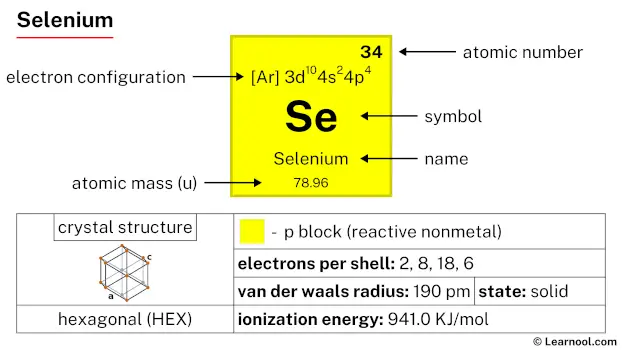 Selenium |
35 Br 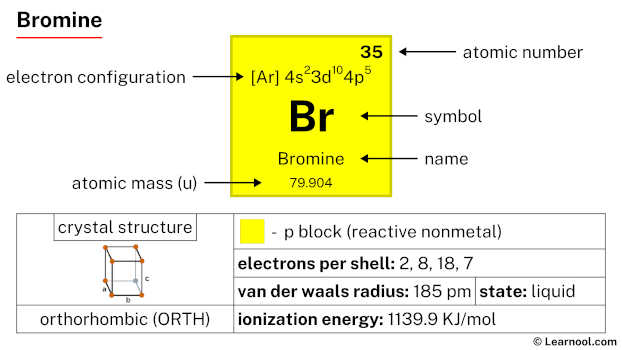 Bromine |
36 Kr  Krypton |
|
| 5 | 37 Rb 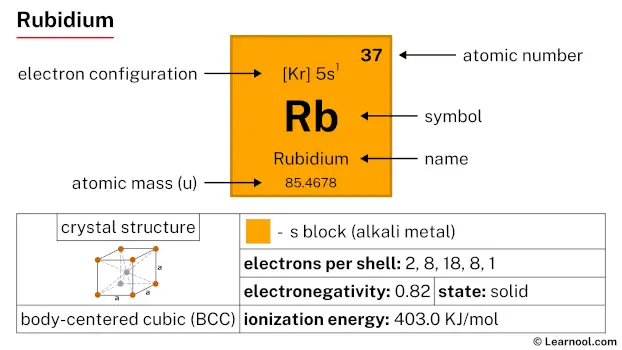 Rubidium |
38 Sr 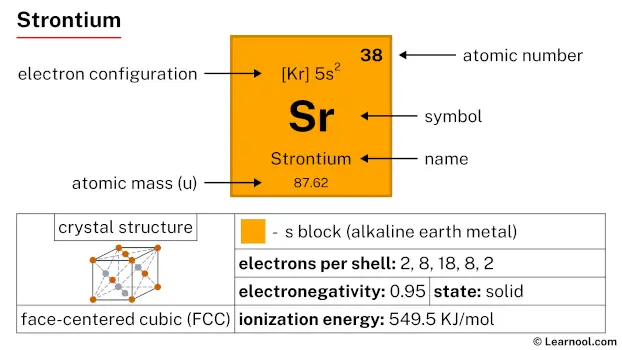 Strontium |
39 Y 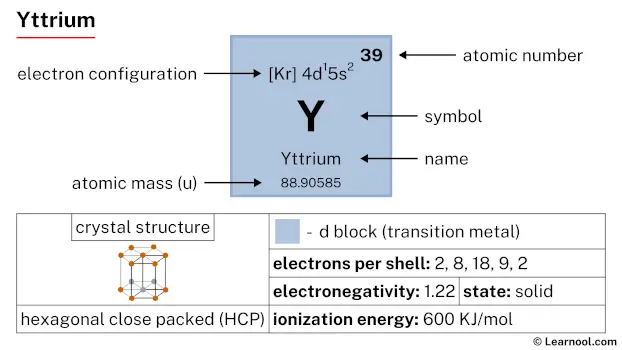 Yttrium |
40 Zr 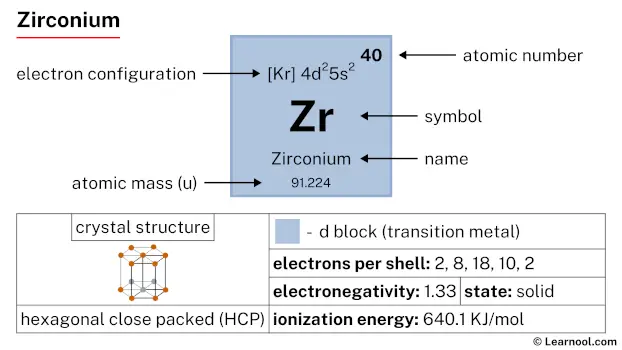 Zirconium |
41 Nb 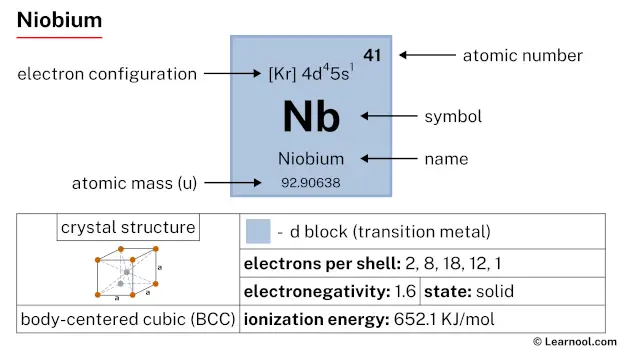 Niobium |
42 Mo 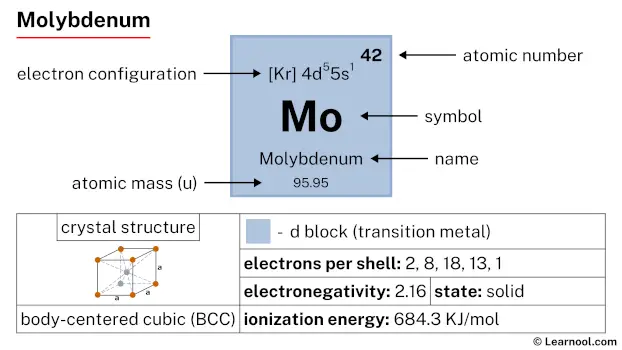 Molybdenum |
43 Tc 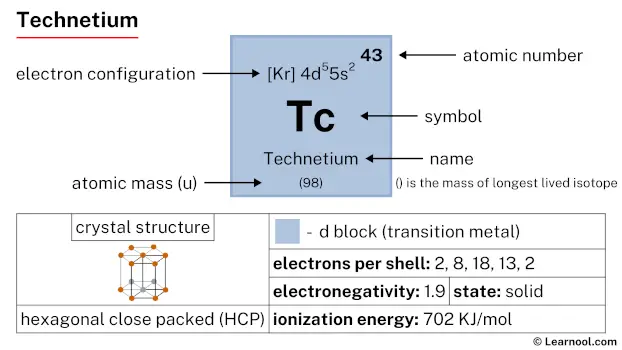 Technetium |
44 Ru 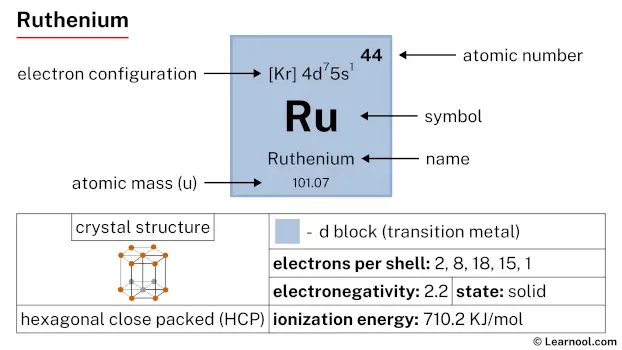 Ruthenium |
45 Rh 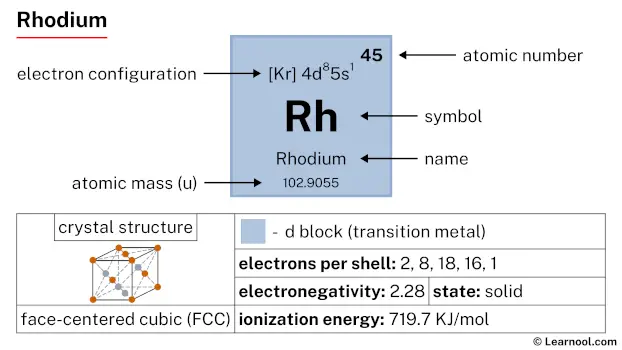 Rhodium |
46 Pd  Palladium |
47 Ag  Silver |
48 Cd 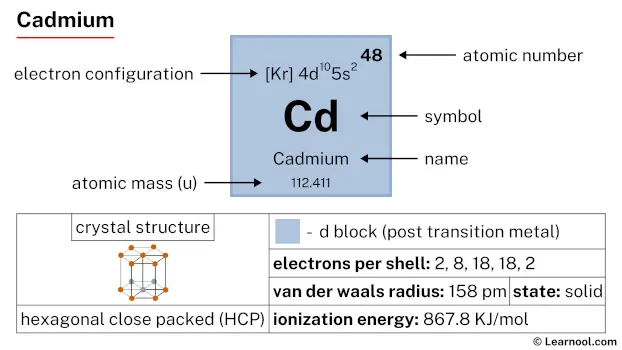 Cadmium |
49 In 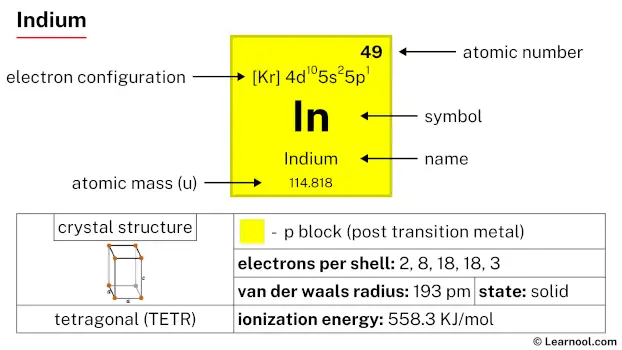 Indium |
50 Sn 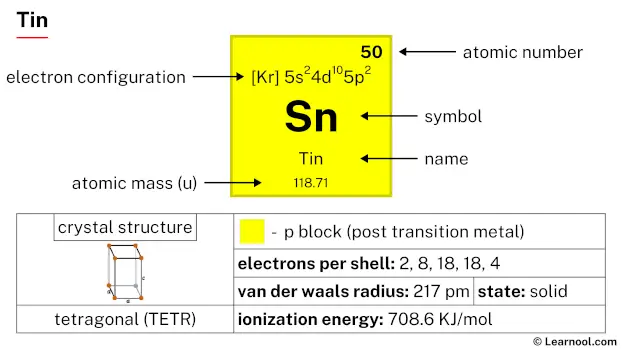 Tin |
51 Sb 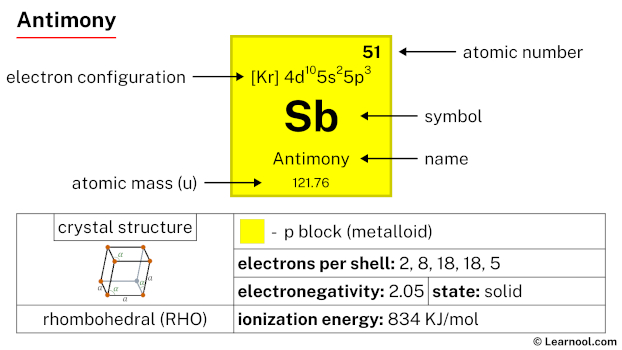 Antimony |
52 Te 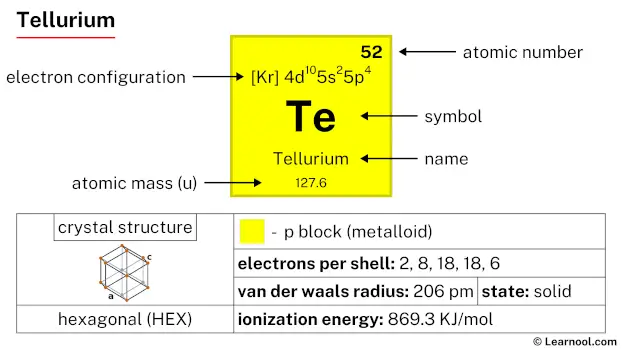 Tellurium |
53 I Iodine |
54 Xe 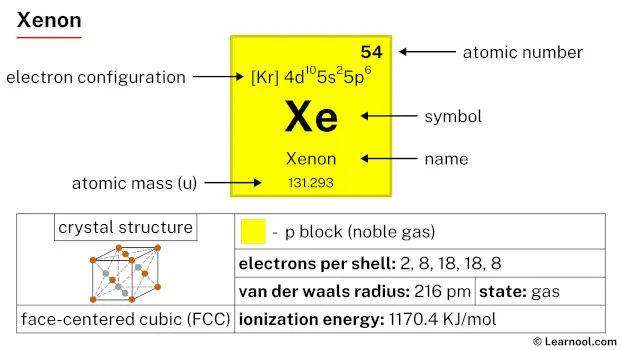 Xenon |
|
| 6 | 55 Cs 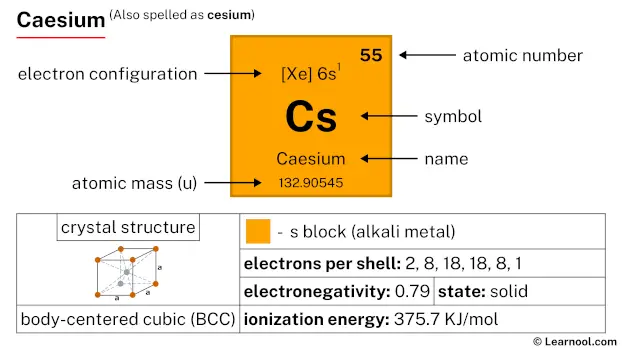 Caesium |
56 Ba 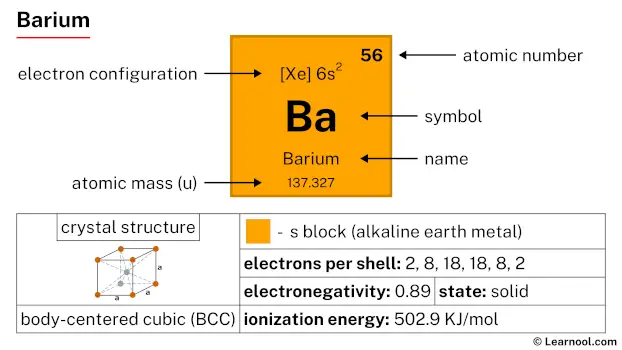 Barium |
72 Hf 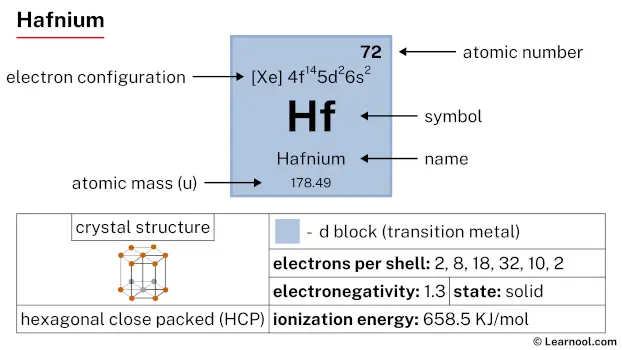 Hafnium |
73 Ta 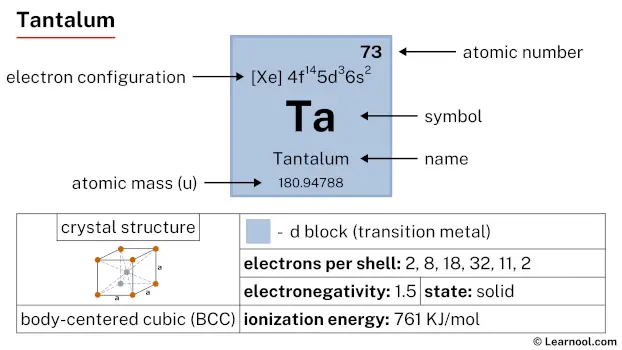 Tantalum |
74 W 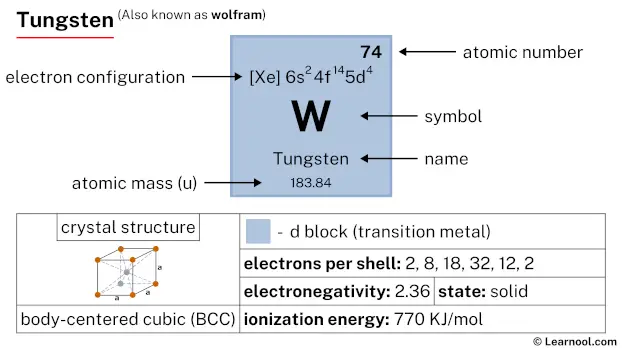 Tungsten |
75 Re 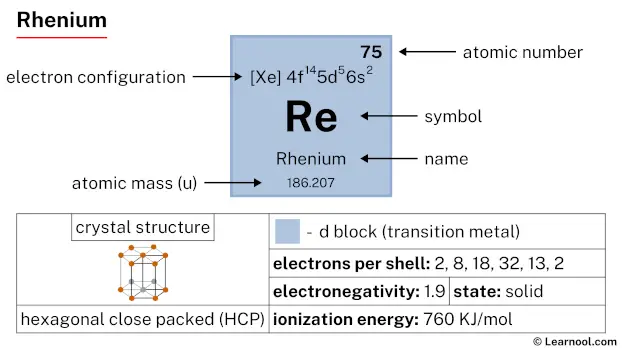 Rhenium |
76 Os 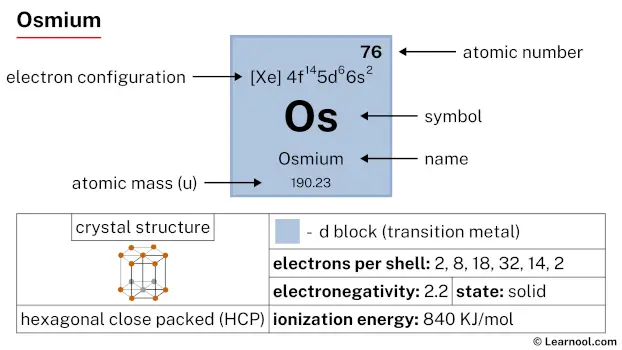 Osmium |
77 Ir 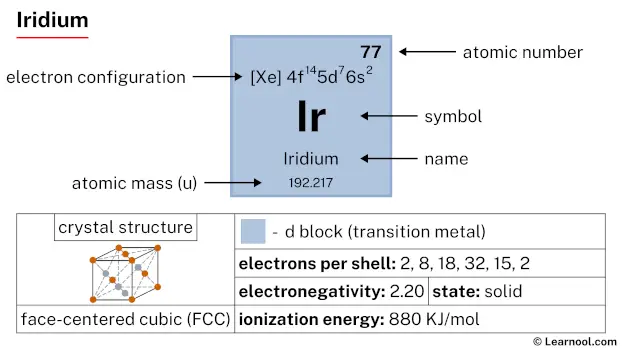 Iridium |
78 Pt  Platinum |
79 Au  Gold |
80 Hg 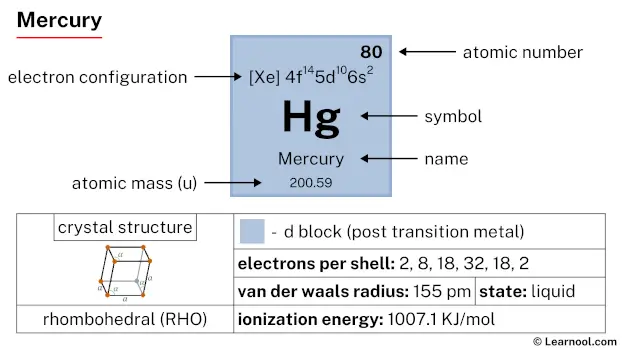 Mercury |
81 Tl 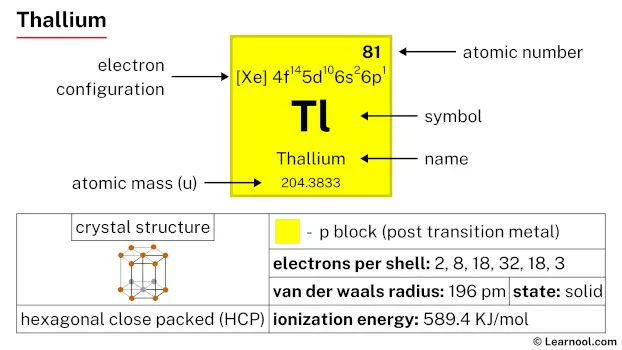 Thallium |
82 Pb  Lead |
83 Bi 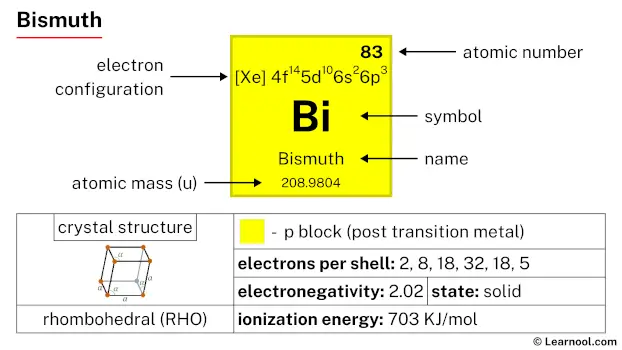 Bismuth |
84 Po 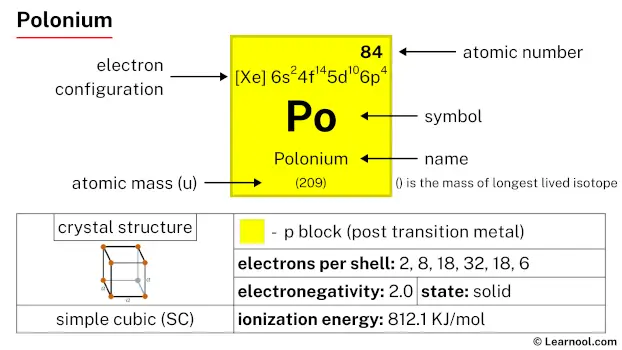 Polonium |
85 At 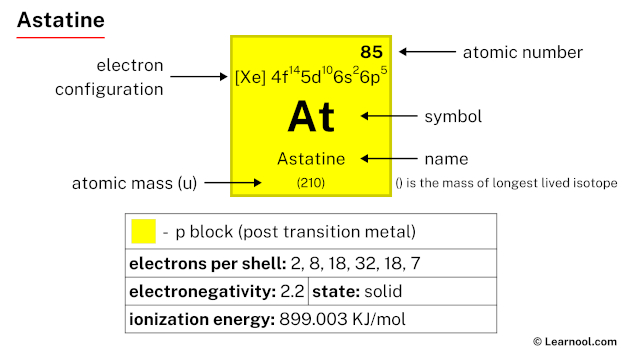 Astatine |
86 Rn 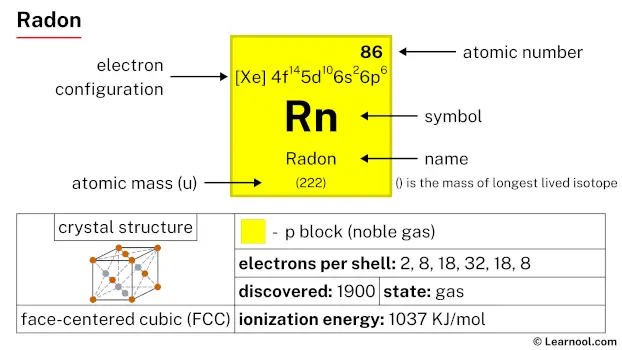 Radon |
||
| 7 | 87 Fr 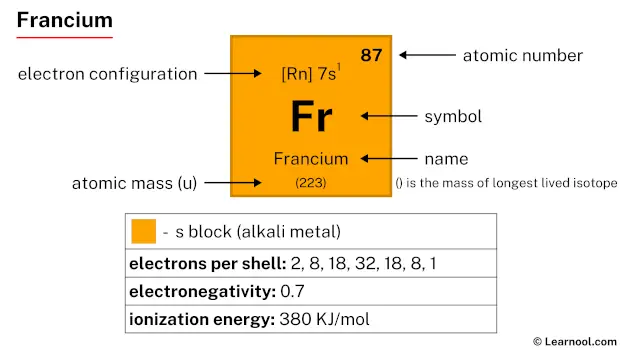 Francium |
88 Ra 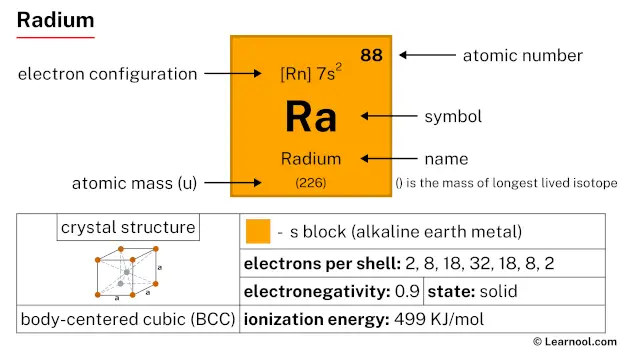 Radium |
104 Rf 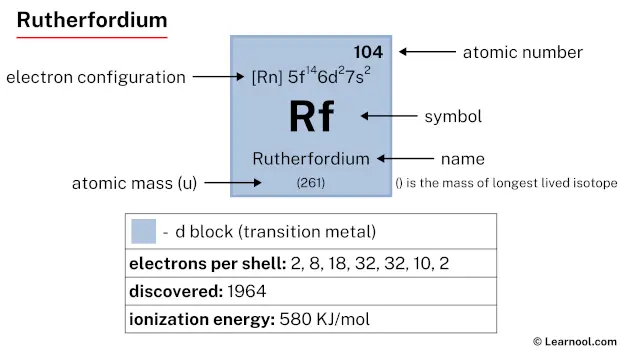 Rutherfordium |
105 Db 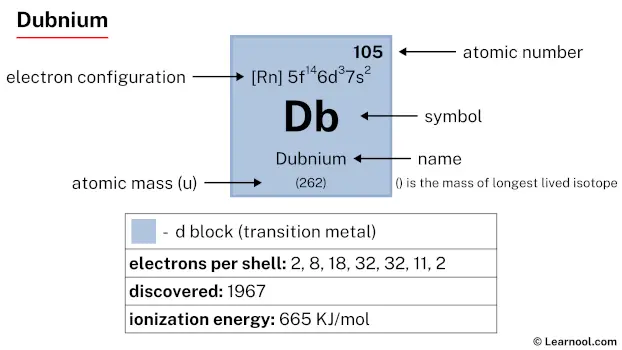 Dubnium |
106 Sg 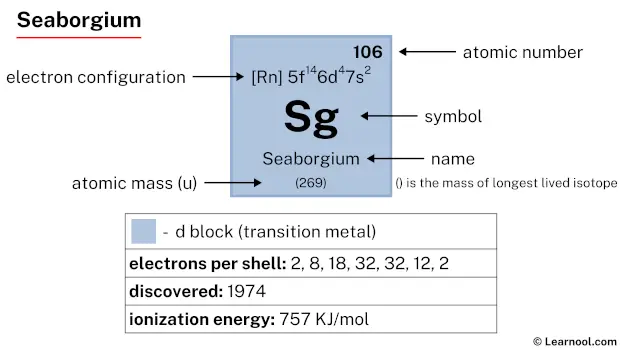 Seaborgium |
107 Bh 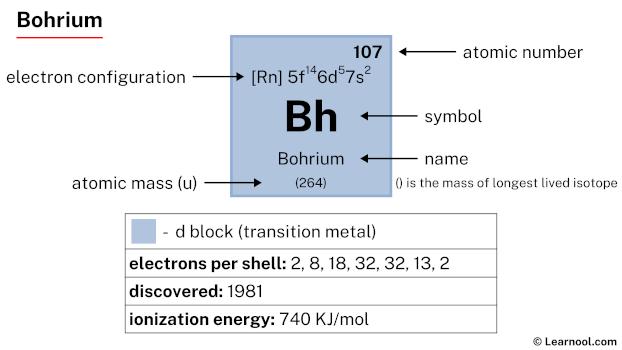 Bohrium |
108 Hs 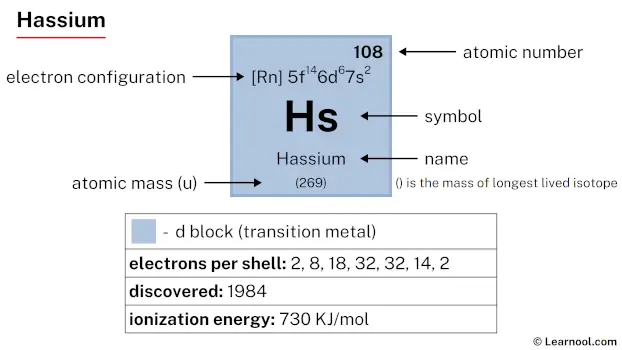 Hassium |
109 Mt 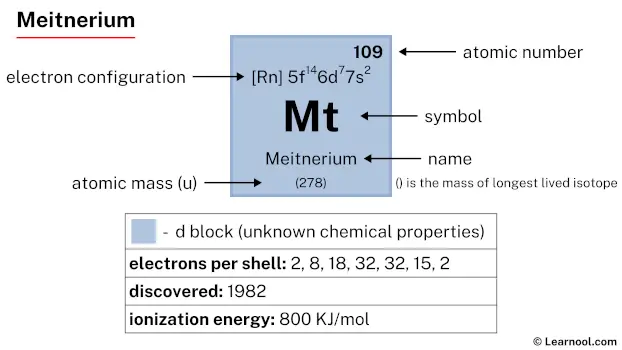 Meitnerium |
110 Ds 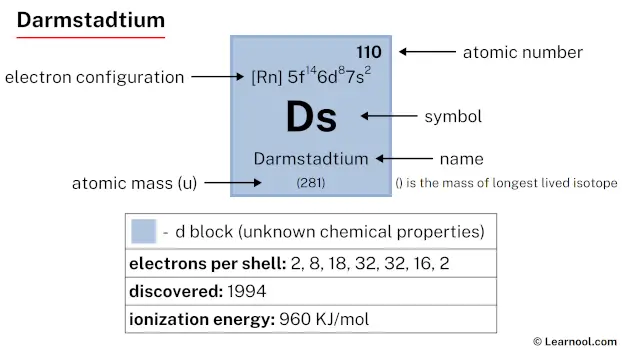 Darmstadtium |
111 Rg 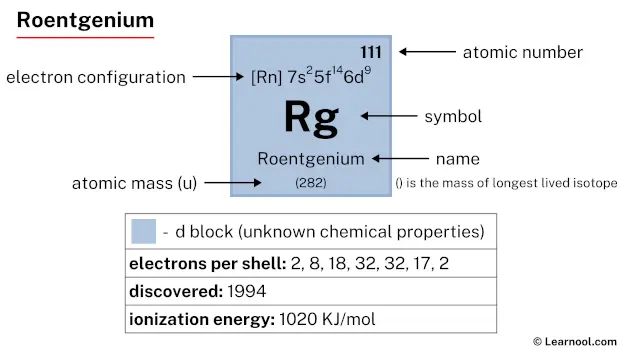 Roentgenium |
112 Cn  Copernicium |
113 Nh 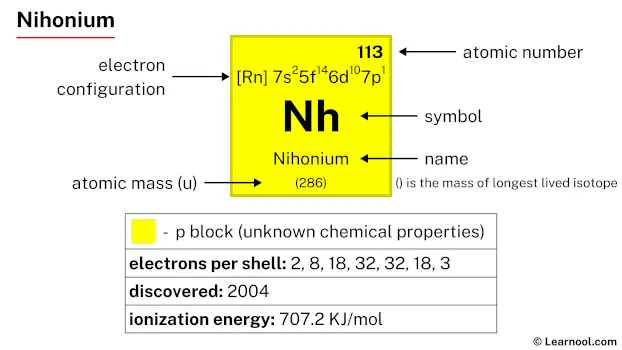 Nihonium |
114 Fl 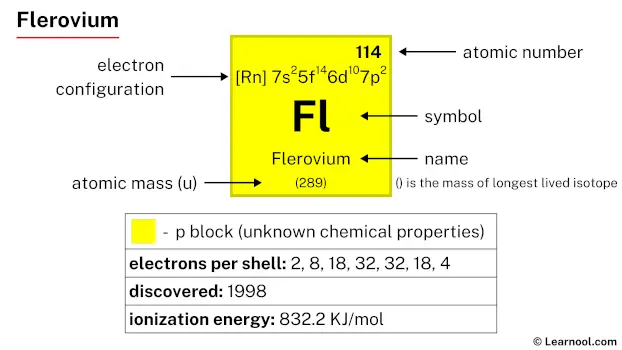 Flerovium |
115 Mc 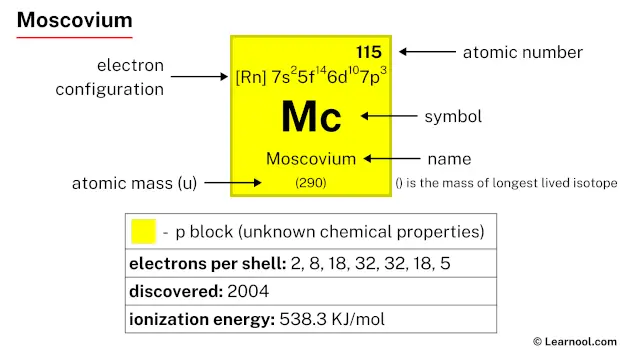 Moscovium |
116 Lv 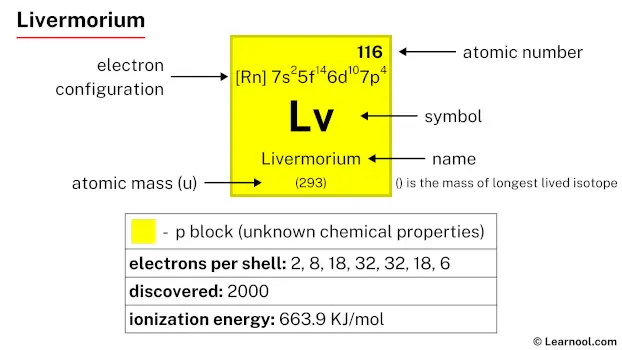 Livermorium |
117 Ts 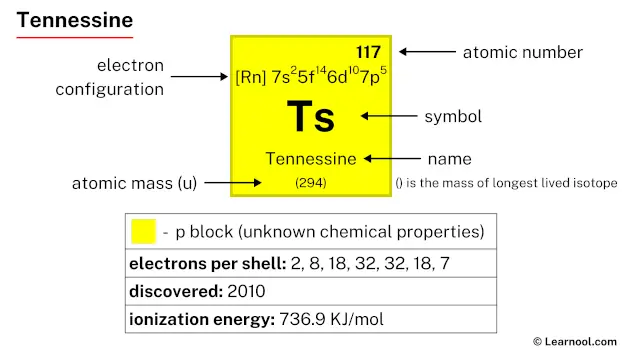 Tennessine |
118 Og 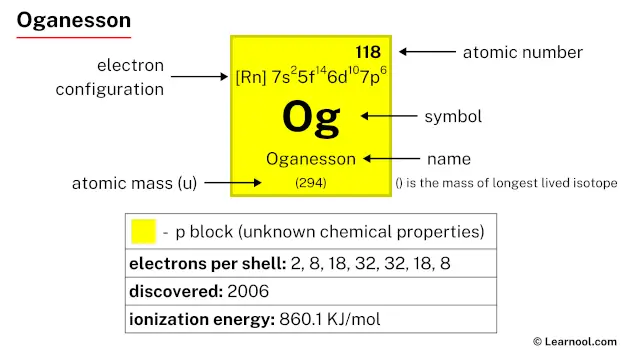 Oganesson |
||
| 57 La 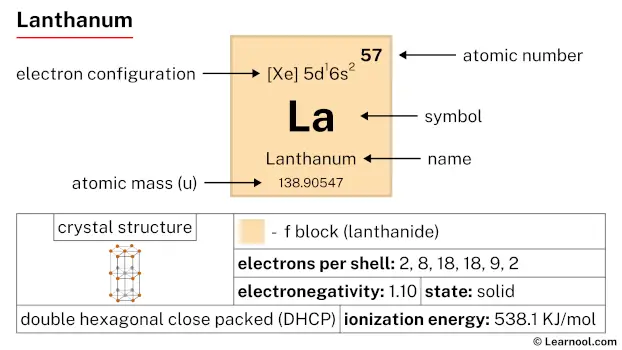 Lanthanum |
58 Ce 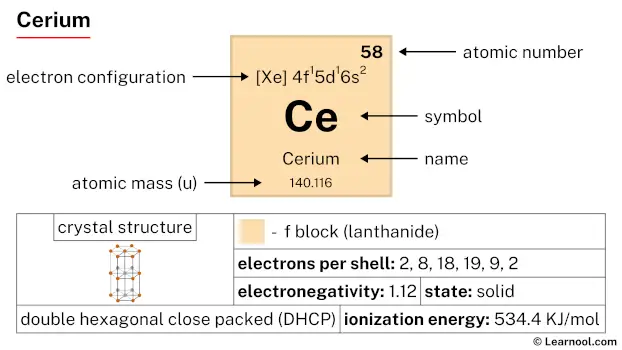 Cerium |
59 Pr 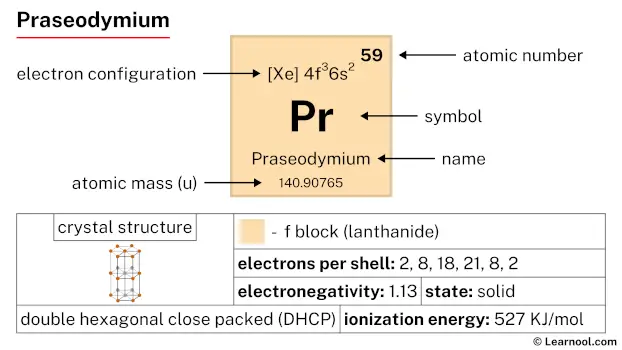 Praseodymium |
60 Nd 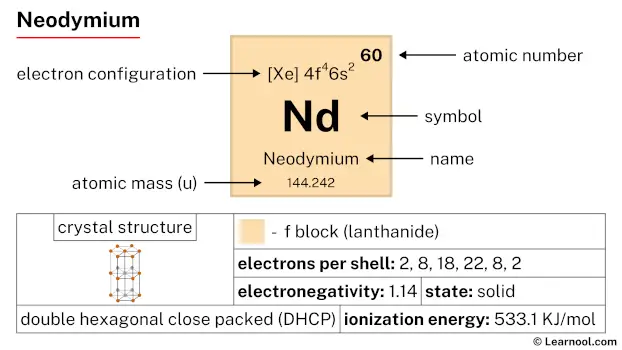 Neodymium |
61 Pm 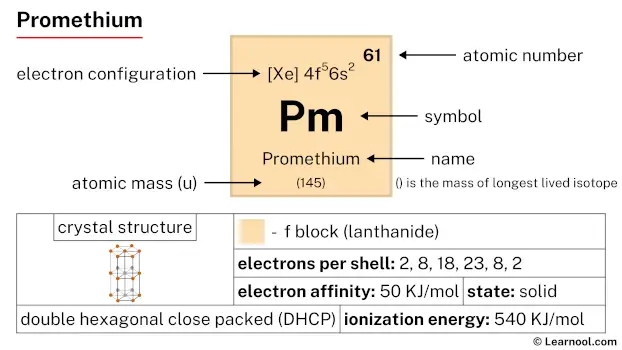 Promethium |
62 Sm 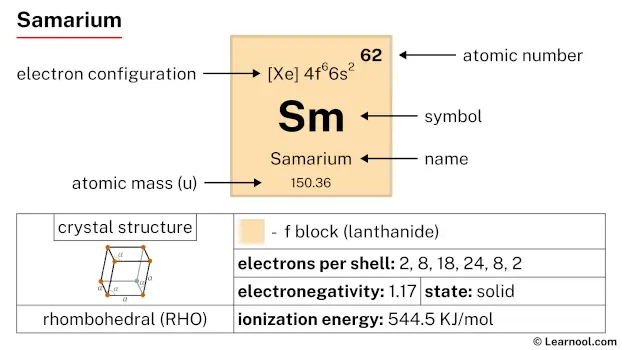 Samarium |
63 Eu 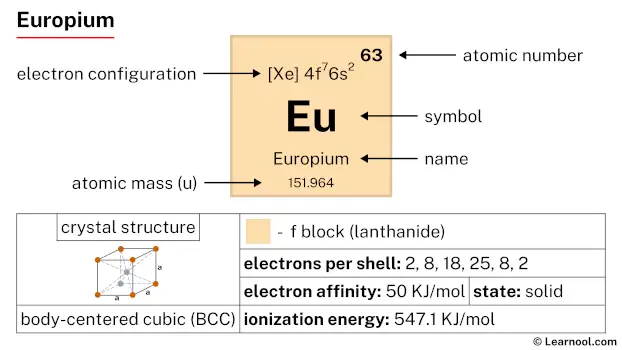 Europium |
64 Gd 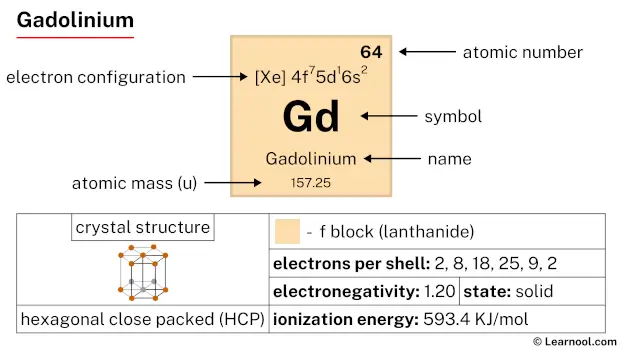 Gadolinium |
65 Tb 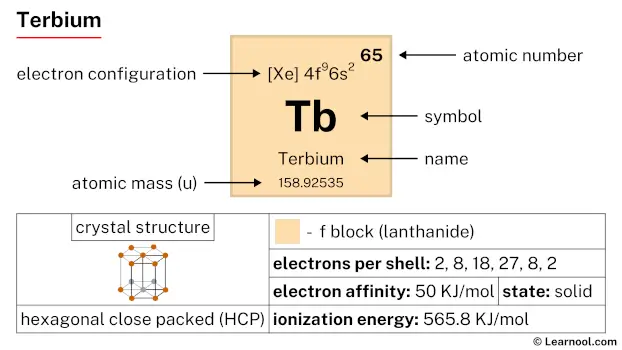 Terbium |
66 Dy 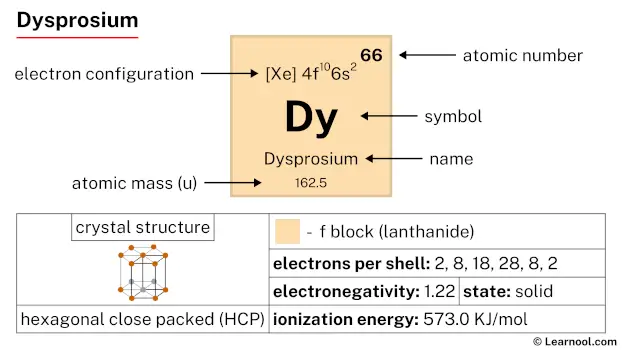 Dysprosium |
67 Ho 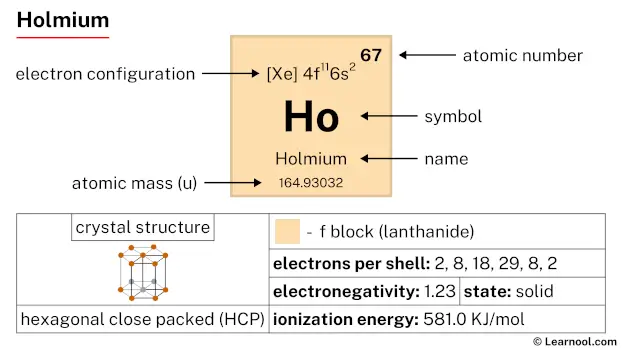 Holmium |
68 Er 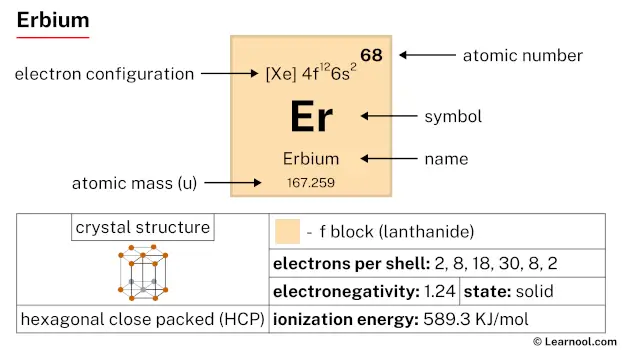 Erbium |
69 Tm 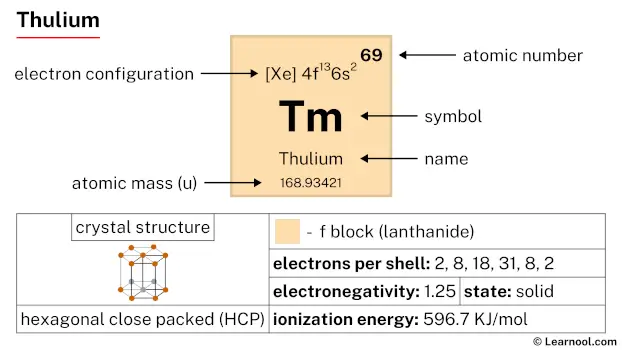 Thulium |
70 Yb 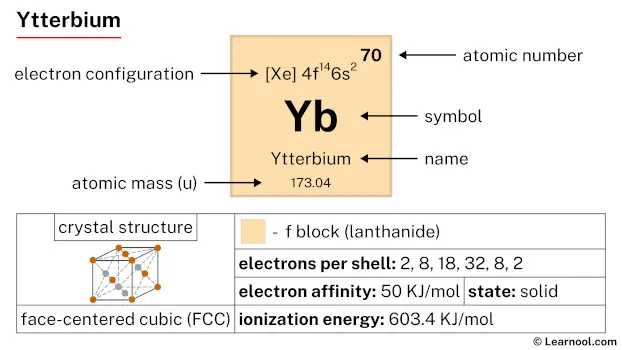 Ytterbium |
71 Lu 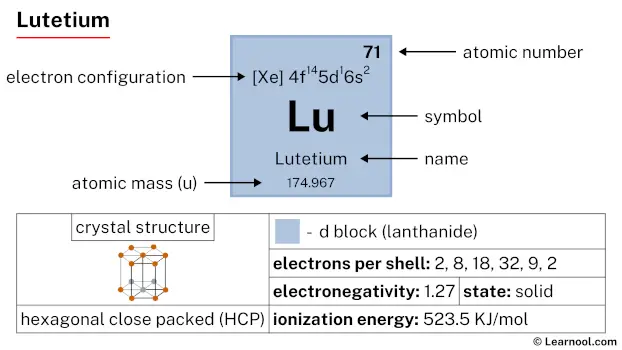 Lutetium |
|||||
| 89 Ac 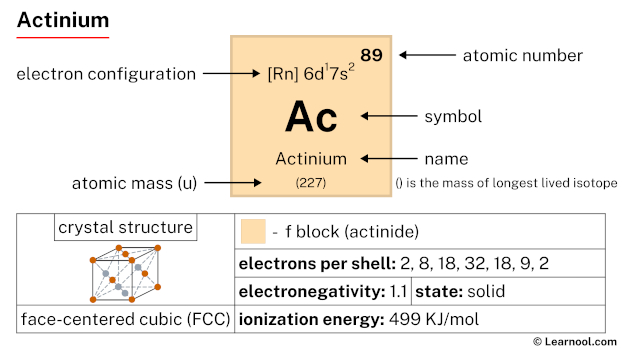 Actinium |
90 Th 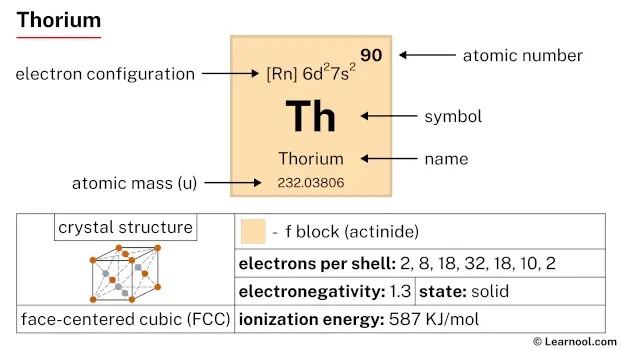 Thorium |
91 Pa 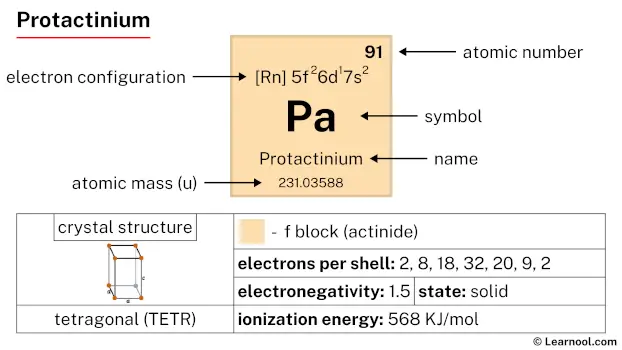 Protactinium |
92 U 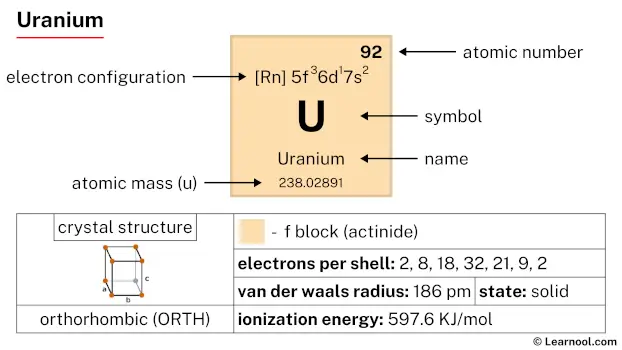 Uranium |
93 Np 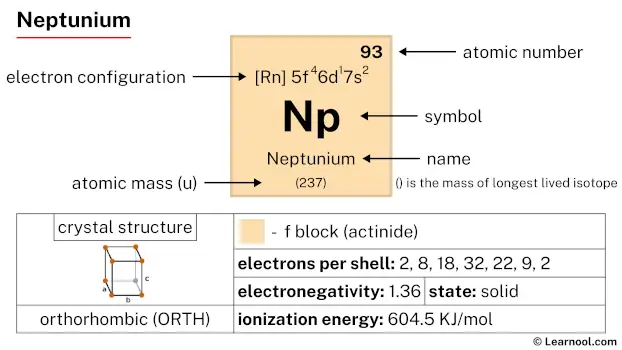 Neptunium |
94 Pu 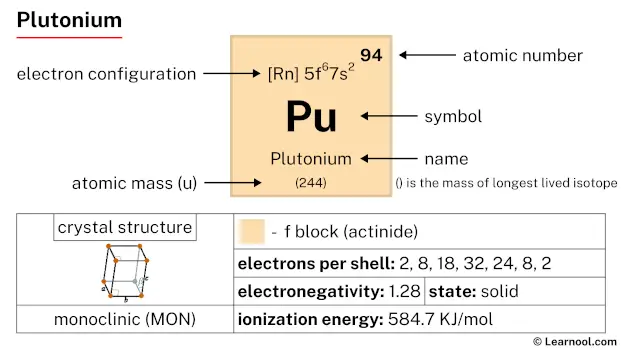 Plutonium |
95 Am  Americium |
96 Cm 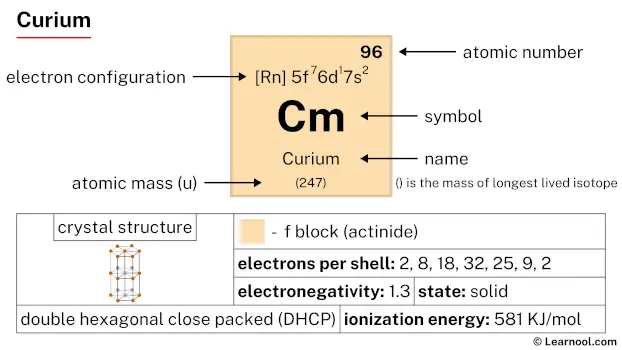 Curium |
97 Bk 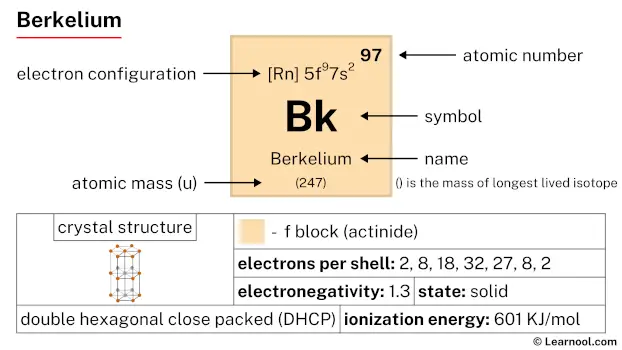 Berkelium |
98 Cf 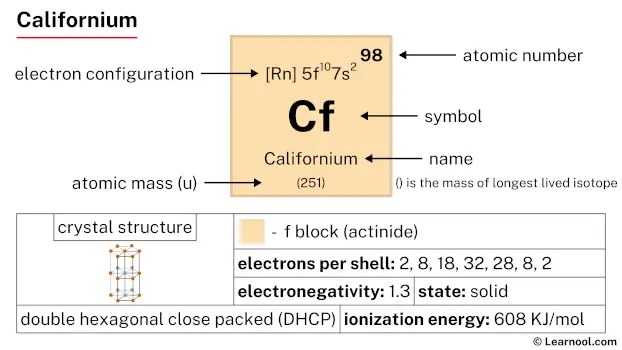 Californium |
99 Es 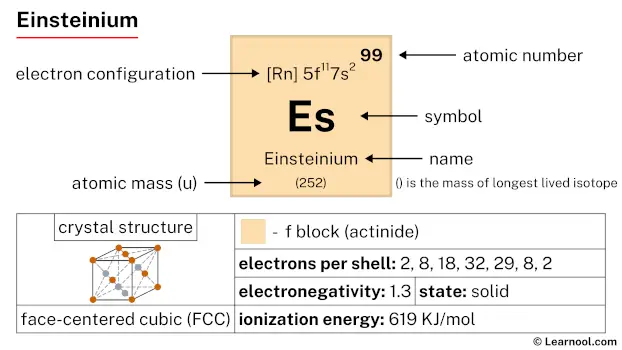 Einsteinium |
100 Fm 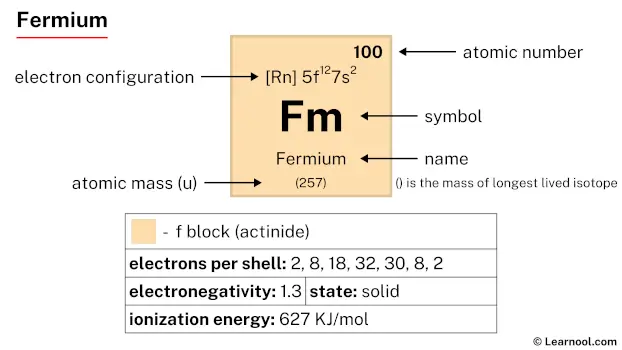 Fermium |
101 Md 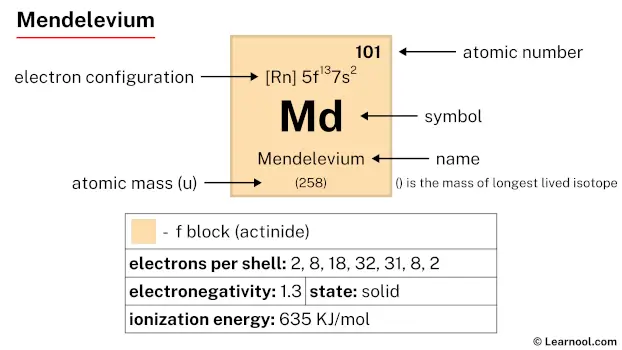 Mendelevium |
102 No 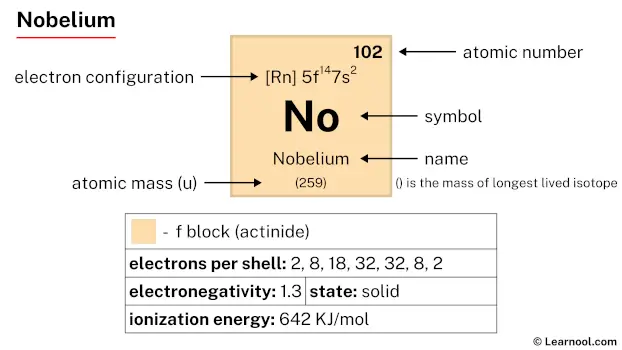 Nobelium |
103 Lr 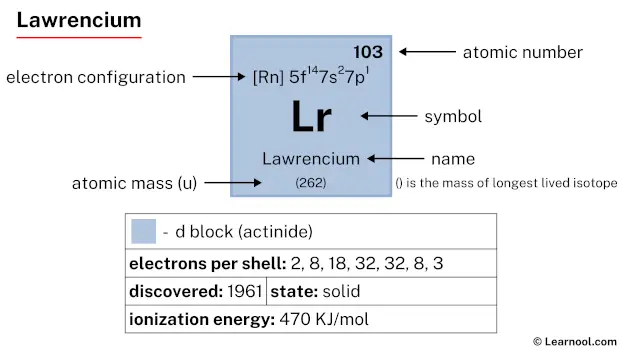 Lawrencium |
|||||
| – p block |
Iodine is a p-block element, situated in the seventeenth column, also known as the halogen group of the periodic table, between tellurium (Te) and xenon (Xe). It has the atomic number 53 and is denoted by the symbol I.
Element information
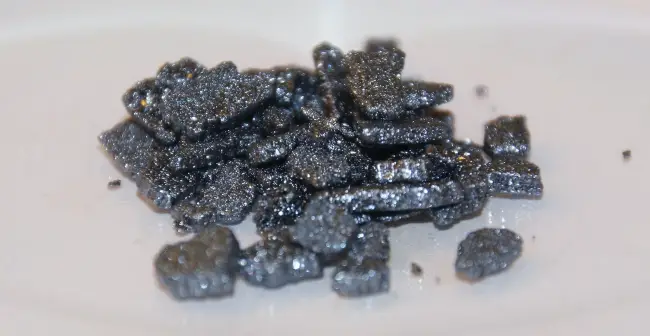 |
|
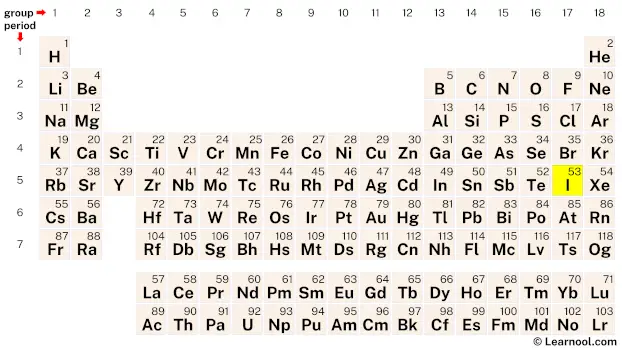 |
|
| Origin of name | Greek word “iodes” (which means violet) |
| Symbol | I |
| Atomic number (Z) | 53 |
| Atomic mass | 126.90447 u |
| Block | p-block |
| Group | 17 (halogen) |
| Period | 5 |
| Classification | Reactive nonmetal |
| Atomic radius | 140 pm |
| Covalent radius | 139±3 pm |
| Van der Waals radius | 198 pm |
| Melting point | 113.7 ℃, 236.66 ℉, 386.85 K |
| Boiling point | 184.3 ℃, 363.7 ℉, 457.4 K |
| Electron configuration | [Kr] 4d10 5s2 5p5 |
| Electrons per shell | 2, 8, 18, 18, 7 |
| Crystal structure | Base-centered orthorhombic |
| Phase at r.t | Solid |
| Density near r.t | 4.933 g/cm3 |
| Main isotopes | Iodine-127 |
| Natural occurrence | Primordial |
| Oxidation state | -1, +1, +3, +5, +7 |
| Electronegativity (Pauling scale) | 2.66 |
| Protons Neutrons Electrons |
53 74 53 |
| Learn how to find: Iodine protons neutrons electrons | |
| Valence electrons | 7 |
| CAS number | 7553-56-2 |
| Discovered by | Bernard Courtois in 1811 |
History
Iodine has a rich and interesting history. It was discovered by a French chemist, Bernard Courtois, in 1811. Courtois was attempting to extract potassium nitrate from seaweed ash and accidentally discovered iodine when he added sulfuric acid to the ash. The resulting purple vapors led him to the discovery of iodine.
The element was named “iodine” from the Greek word “iodes,” meaning violet, because of the violet color of its vapors. It was not long before iodine was recognized as an important element in medicine. In the early 19th century, it was used to treat various medical conditions, such as goiter, a swelling of the thyroid gland.
In the mid-19th century, iodine was discovered to be an essential element in the human body, necessary for the production of thyroid hormone. This led to the widespread use of iodine in the production of table salt, which is now fortified with iodine in many countries.
In addition to its medical applications, iodine also played an important role in the development of photography. In the early days of photography, iodine was used to sensitize photographic plates to light. It was later replaced by other chemicals, but its importance in the history of photography cannot be denied.
Today, iodine is used in a variety of applications, including as a disinfectant, a catalyst, and a reagent in organic chemistry. It also has important applications in nuclear medicine, where it is used in the diagnosis and treatment of thyroid diseases.
Occurrence and production
Iodine is a relatively rare element in the Earth’s crust, occurring at an average abundance of 0.05 parts per million. It is typically found in seawater, as well as in the earth’s crust and in certain minerals such as sodium nitrate deposits in Chile. In seawater, iodine exists primarily as iodide, which can be concentrated and extracted through various means.
One of the primary sources of iodine is seaweed, which can contain high concentrations of the element due to its absorption from seawater. Other sources include deep groundwater in some areas, as well as certain rocks and sediments. In some regions, iodine deficiency can be a significant issue due to the low levels of the element in local soil and water sources.
The majority of iodine production today comes from brine wells and seawater. In brine wells, underground salt water is pumped to the surface and treated to remove impurities. The brine is then treated with oxidizing agents to convert iodide to iodine. The iodine is then separated and purified through a series of chemical processes, including distillation, absorption, and electrolysis.
Seawater is also a major source of iodine, and is typically treated with chemicals such as chlorine to oxidize iodide to iodine. The iodine is then separated and purified using a similar process to that used for brine wells. Some iodine is also produced as a byproduct of nitrate mining, as sodium nitrate deposits in Chile can contain significant amounts of iodine.
Properties
Physical properties
Iodine has a dark gray to black color and a lustrous appearance when solid.
It is a relatively soft and brittle solid.
Its melting point is 113.7 ℃, and its boiling point is 184.3 ℃.
Iodine has a high vapor pressure, and it sublimes readily at room temperature, forming a purple vapor.
Chemical properties
Iodine is a highly reactive element and readily forms compounds with many other elements and compounds.
It reacts with most metals to form iodides, and with nonmetals to form covalent compounds.
Iodine can react with hydrogen to form hydrogen iodide, a strong acid.
It is a strong oxidizing agent and can react with reducing agents to form iodides.
Biological properties
Iodine is an essential element for human health, as it is required for the synthesis of thyroid hormones in the body.
It is used in the treatment of thyroid-related disorders such as goiter and hypothyroidism.
Iodine deficiency can lead to serious health problems, including intellectual disability, developmental delays, and thyroid disease.
Environmental properties
Iodine is present in small amounts in seawater, and it is concentrated in some seaweed and marine animals.
It is released into the environment through natural processes such as volcanic eruptions and seawater evaporation.
Iodine can also be released into the environment through human activities such as nuclear power generation and the use of iodine-containing disinfectants.
Applications
Iodine is used in medicine as a disinfectant, antiseptic, and topical antibiotic. It is also used to treat various thyroid-related conditions, such as goiter, thyroid cancer, and hyperthyroidism.
Iodine is used as a contrast agent in X-ray, CT, and MRI imaging to enhance the visibility of internal organs and tissues.
Iodine is used in photography as a sensitizing agent for silver halide emulsions.
Iodine is added to animal feed as a supplement to prevent iodine deficiency, which can lead to goiter and other health problems in livestock.
Iodine is used in various industrial applications, such as the production of nylon, acetic acid, and certain organic compounds.
Iodine is used to disinfect water in emergency situations, where other water treatment methods are not available.
Iodine is used to test for the presence of starch in foods and other products.
Iodine-131, a radioactive isotope of iodine, is used in nuclear medicine for diagnostic and therapeutic purposes, particularly in the treatment of thyroid cancer.
Iodine is used in analytical chemistry as a reagent for the determination of various substances, such as vitamin C, sugars, and alkaloids.
Interesting facts
Iodine is named after the Greek word “iodes,” meaning violet, due to the violet color of iodine vapor.
Iodine is the least reactive halogen element, making it a poor oxidizing agent.
Iodine is essential for the production of thyroid hormones, which regulate metabolism in the body.
Iodine is used as a disinfectant and antiseptic, particularly in the medical field.
Iodine is commonly used in the production of various chemicals, including pharmaceuticals, dyes, and photographic film.
Iodine is relatively rare in the Earth’s crust, with an abundance of only 0.05 parts per million.
Iodine is often found in seawater and seaweed, and is an important nutrient for marine life.
Iodine can be detected with a starch test, which involves adding a small amount of starch to a solution containing iodine; the resulting color change indicates the presence of iodine.
Iodine has been used historically as a treatment for goiter, a swelling of the thyroid gland caused by iodine deficiency.
Iodine is also used in the production of iodized salt, which is fortified with iodine to prevent iodine deficiency in populations where natural sources of iodine are limited.
Related
More elements
External links
- https://www.rsc.org/periodic-table/element/53/iodine
- https://www.britannica.com/science/iodine
- https://en.wikipedia.org/wiki/Iodine
- https://www.chemicool.com/elements/iodine.html
- https://pubchem.ncbi.nlm.nih.gov/element/Iodine
- https://chemistrytalk.org/iodine-element/
- https://education.jlab.org/itselemental/ele053.html
- https://www.livescience.com/37441-iodine.html
Deep
Learnool.com was founded by Deep Rana, who is a mechanical engineer by profession and a blogger by passion. He has a good conceptual knowledge on different educational topics and he provides the same on this website. He loves to learn something new everyday and believes that the best utilization of free time is developing a new skill.
